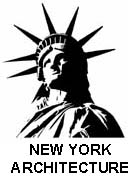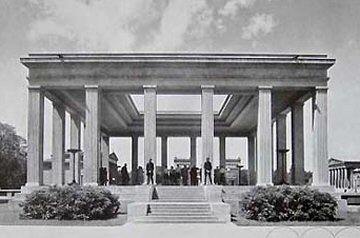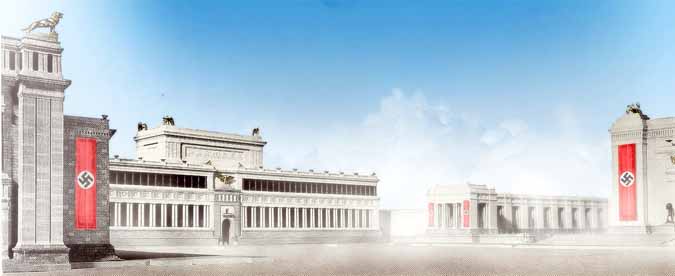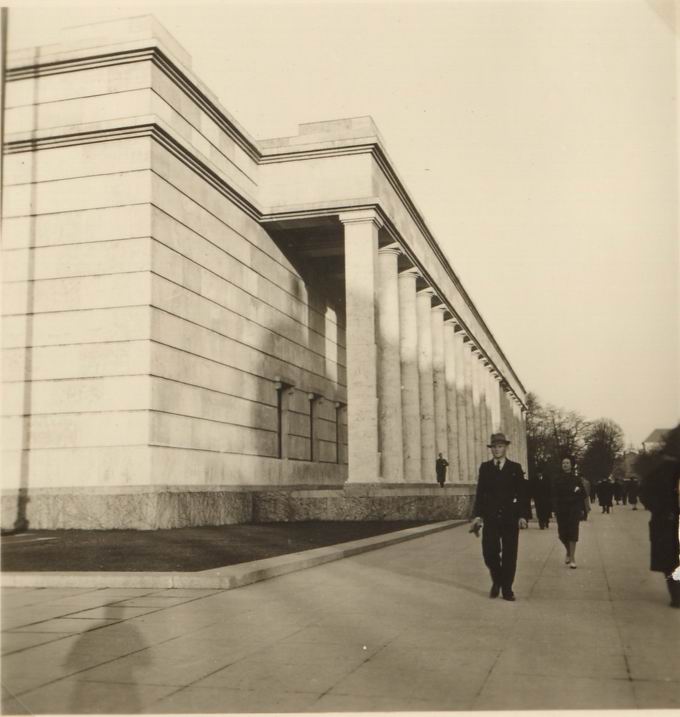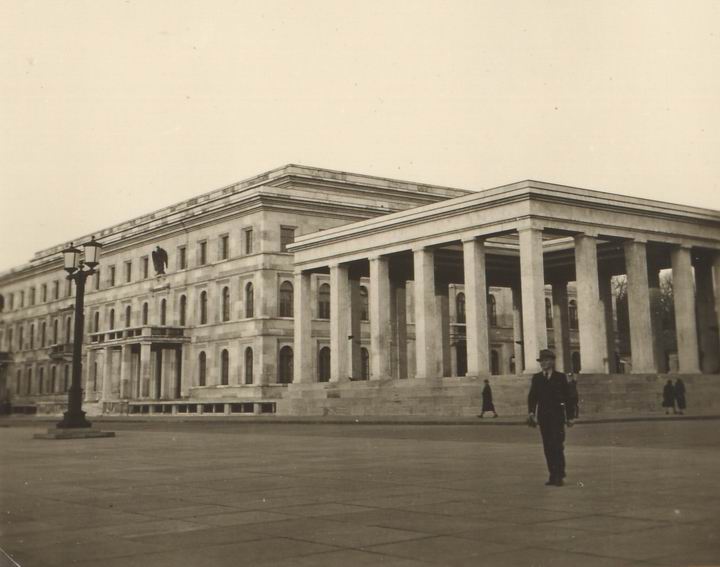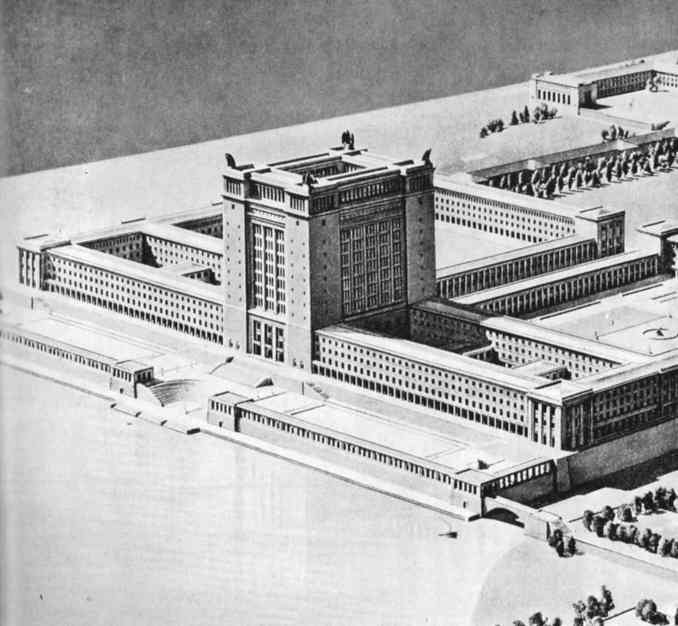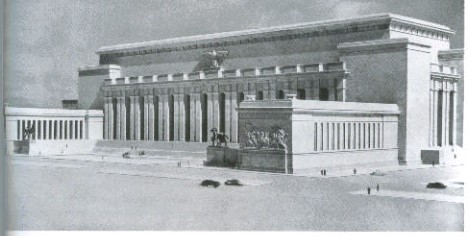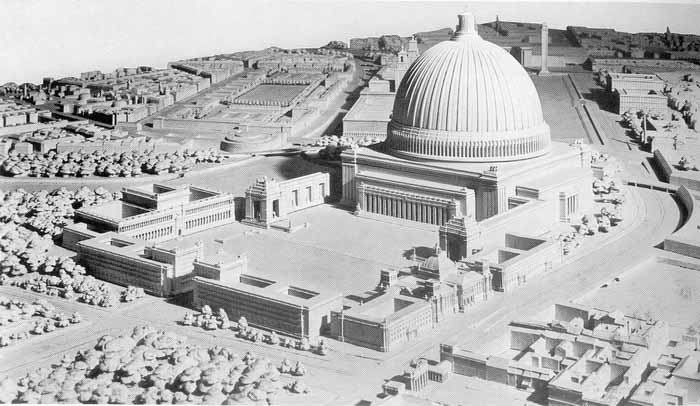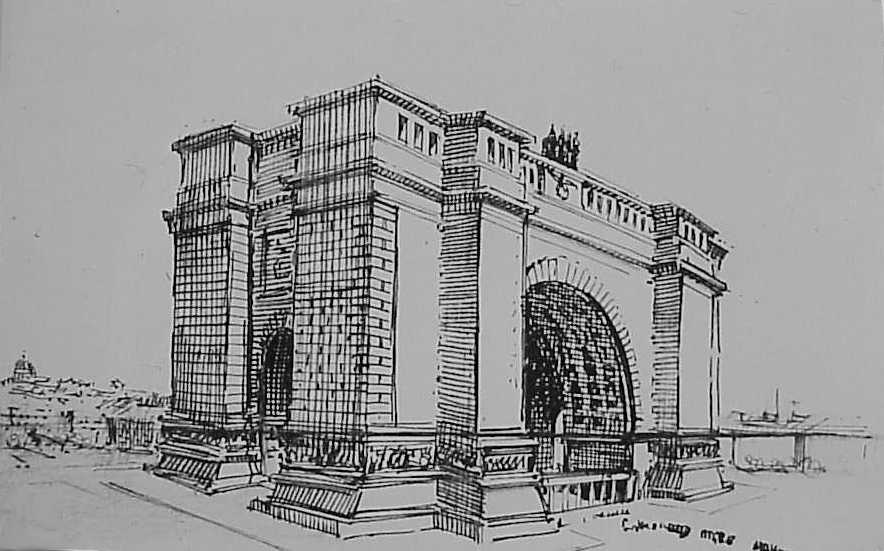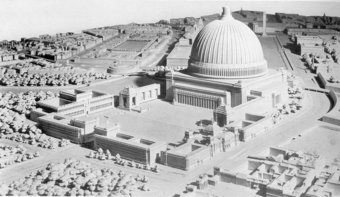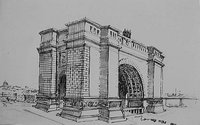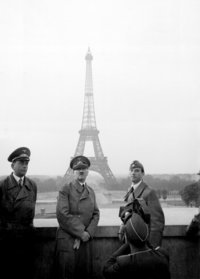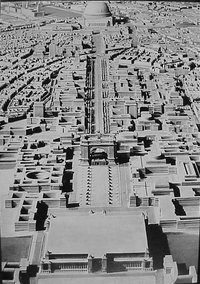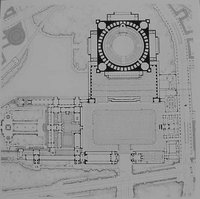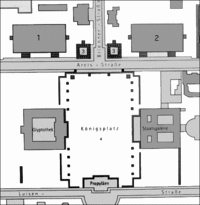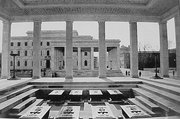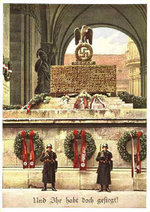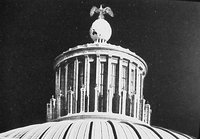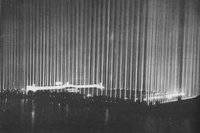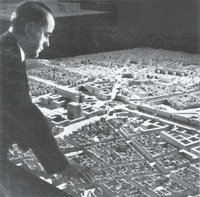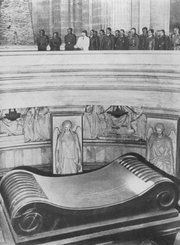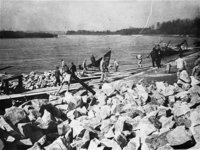Nazi architecture
From Wikipedia, the free encyclopedia.
Introduction
Nazi architecture is an often dismissed and derided aspect of Nazi plans to create a cultural and spiritual rebirth in Germany.
Hitler, founder of the Third Reich, admirer of imperial Rome, yet aware that the ancient Germans were never Romanized and were traditionally regarded by the Romans as enemies of the Pax Romana, developed architecture in the neo-classic style and erected edifices as cult sites for the Nazi party a type of Victory Altar borrowed from the alleged racial ancestors of the Germans - the Greeks. His dilemma was that because of his admiration for the Classical cultures of the ancient Mediterranean, he could not isolate and politicize German antiquity, as Mussolini had done with respect to Roman antiquity. Therefore he had to import political symbols into Germany and justify their presence on the grounds of a spurious racial ancestry, the myth that Greeks and the Romans were the ancestors of the Germans (Scobie 92).
Hitler's fantasies about being the founder of a thousand-year Reich were in harmony with the Colosseum being associated with eternity. Hitler envisioned all future Olympic games to be held in Germany in the Deutsche Stadion. It is clear that Hitler anticipated that after winning the war, a subjected world would have no choice but to send its athletes to Germany every time the Olympic games were held. Thus, this building foreshadowed Hitler's craving for world domination long before this aim was put into words (Scobie 80). Hitler habitually derived satisfaction from seeing world-famous monuments being surpassed in size by German equivalents. However, architectural elephantiasis alone does not explain the full significance of the choice of edifice (Scobie 91).
Most regimes, especially new ones, wish to make their mark both physically and emotionally on the places they rule. The most tangible way of doing so is by constructing buildings and monuments. Architecture is the only art form that can actually physically meld not only the world, but the people who inhabit it. It forces people to move in a determined way, to look at specific things and conduct their lives in certain ways. Architecture affects not only the physical environment, but mental environment of the populace. The Nazis believed architecture played a key role in creating their new order.
Hitler the architect
Hitler was quite fond of the numerous theatres built by Hermann Helmer and Ferdinand Fellner, who built in the late baroque style. In addition, he appreciated the stricter architects of the nineteenth century such as Gottfried Semper, who built the Opera House, the Picture Gallery in Dresden, the court museums in Vienna and Theophil Hansen, who designed several buildings in Athens in 1940. He raved about the Paris Opera and Palace of Justice by the architect Poelaert.
Ultimately, he was always drawn back to inflated neobaroque such as Kaiser Wilhelm II had fostered, through his court architect Ihne. Fundamentally, it was decadent baroque comparable to the style that accompanied the decline of the Roman Empire. Thus, in the realm of architecture, as in painting and sculpture, Hitler really remained arrested in the world of his youth: the world of 1880 to 1910, which stamped its imprint on his artistic taste as on his political and ideological conceptions (Speer, Third Reich, 75-76).
The Führer did not have one particular style; there was no official architecture of the Reich only the neoclassical baseline that was enlarged, multiplied, altered and exaggerated, sometimes to the point of ludicrousness. Hitler appreciated the permanent qualities of the classical style as it had a relationship between the Dorians and his own Germanic world.
It would be a mistake to try to look within Hitler's mentality for some ideologically based architectural style. That would not have been in keeping with his pragmatic way of thinking (Speer, Third Reich, 75-76).
Three primary roles
Nazi architecture has three primary roles in the creation of their new order: (i) Stage; (ii) Symbolic; (iii) Didactic (http://en.wiktionary.org/wiki/Didactic). In addition, they saw architecture as a method of producing buildings that had a function, but also served a larger purpose. For example, the House of German Art had the function of housing art, but through its form, style and design it had the purpose of being a community structure built using an Aryan style, which acted as a kind of temple to acceptable German art.
Stage
Many Nazi buildings were stages for communal activity, creations of space for the construction of the myths on which the National Socialist ideology was based. From Albert Speer's seemingly iconoclastic use of banners for the May Day celebrations in the Lustgarten, to the Nazi co-option of the 'Thing' tradition, the Nazis wanted to link themselves to a German past.
The link could be direct; a Thingplatz or Thingstätte was a meeting place near or directly on a site of supposed special historical significance, used for the holding of festivals associated with a Germanic past. This was an attempt to link the German people back to both their history and their land. The use of 'Thing' places was closely associated with the 'blood and soil' part of Nazi ideology, which involved the perceived right of those of German blood to occupy German land. The Thingplatz would contain structures, which often included natural objects like stones and were built in the most natural setting possible. These structures would be built following the pattern of an ancient Greek theatre, following a structure of an historical culture considered to be Aryan. This stressing of a physical link between the past and Nazism aided to legitimatize the Nazi view of history, or even the Nazi regime itself. Still, the 'Thing' movement was not successful.
The link could be indirect; the May Day celebrations of 1936 in Berlin took place in a Lustgarten that had been transformed into a stage. This transformation was not the standard dressing of a specific place but a creation of a new anonymous, pure, cubic space that freed itself from the immediate history of Berlin, the church and the monarchy, yet was still associated with the distant aura of a Hellenic past. This was simply the creation of a new ceremonial place in direct competition with the former Royal Palace and Altes Museum, both even in the 1930s, still symbols of a royal Berlin. The symbolism was clear; any speaker at the event would be standing in front of the Altes Museum, which housed Germany's classical collection that could only be seen by the audience through Nazi banners. There was a link between the new order and the classical past, but the new order was paramount.
The Nazis would bring the community together using architecture, creating a stage for the community experience. These buildings were also solely for the German people, the great hall in Berlin was not a supranational People's House like those being built in the Soviet Union, but the stage where tens of thousands of recharged citizens would enter into a solemn mystic union with the Supreme Leader of the German Nation. The sheer size of the stage itself would magnify the importance of what was being said.
How these stages were set was also an issue, from the most mundane building to the grandest, the form and style used in their construction tell a great deal about and are symbols of those who created them, when they were created and why they were created. Designs of this kind occasionally occur by accident; however, the architectural styles speak to the tastes of those who constructed the building or paid for its construction. It also speaks to the tastes of the general architectural movements of the time and the regional variants that influenced them. Nazi buildings were an expression of the essence of the movement, built as a National Socialist building should be, regardless of the style used.
Symbolic
Determining what National Socialists saw as the concept of Nazi Architecture is problematic. Various members of the leadership had differing views and tastes and commentators see the same style in different ways. Roger Eatwell sees the format used at the Nuremberg rallies as a mixture of Catholic ceremony and left-wing Expressionist form and lighting, while Sir Neville Henderson saw a cathedral of ice. Still, if a building was designed and built using the Nazi version of what was German, it was considered Nazi Architecture.
In general, there were two primary National Socialist styles of architecture. Nazi Architecture in its crudest sense was either a squared-off version of neo-classical architecture, or a mimicry of völkish buildings and structures.
The neo-classical style was primarily used for urban state buildings or party buildings such as the Zeppelinfeld in Nuremberg, the planned Volkshalle for Berlin and the Dietrich Eckart Stage in Berlin. This style was not just used for physical construction, but on the ordered columns of searchlights that formed Speer's 'cathedral of light' used at the Nuremburg Party Rallies.
The völkish style was primarily used in rural settings for accommodation or community structures like the Ordensburg in Krossinsee, the walls and watchtowers of KL Flossenbürg and KL Mauthausen. It was also to be applied to rural new towns as it represented a mythical medieval time when Germany was free of foreign and cosmopolitan influences. This style was also used in a limited way for buildings with modern uses like weather service broadcasting and the administration building for the federal post office.
Most Nazi Architecture was neither novel in style nor concept; it was not supposed to be. Even a cursory inspection of what was intended for Berlin finds analogues all over the world. Long boulevards with important buildings along them can be found in the grid pattern road structures of Washington and New York, the Mall and Whitehall in London, and the boulevards of Paris. Large domes can be found on the buildings of the Mughal Empire of India, the Capitol in Washington, the Pantheon and Basilica di San Pietro in Rome. Even the 'Kraft durch Freude' "Strength through Joy" resort at Prora is not wholly unlike the buildings envisaged by Le Corbusier in his 'City of Three Million Inhabitants'. The building of a formal governmental zone outside the center of an old city or totally on its own had become commonplace by the 1930s. This is not to say their plans were simply an attempt to copy others, but that they were following a pattern already established in human society. The forms used may have been inspired by other city redevelopment plans like Lutyens Delhi, Burnham's Chicago or even Burley Griffin's Canberra, but they were not an attempt to copy them. The Nazis sought not to rebuild, but to build.
National Socialism is often viewed as anti-modern and romantic or having a pragmatic willingness to use modern means in pursuit of anti-modern purposes. This confuses the Nazi dislike of certain styles like the Bauhaus with a blanket dislike of all modern styles. This was based mainly on what the Bauhaus and others were seen as representing, like foreign influences or the decadence of the Weimar Republic. The lack of any human scale details or plain exteriors may have produced an overwhelming effect, but this style was common from the 1910s onwards. This modern approach was not limited to the neo-classical buildings for city centers, but was also used for völkish buildings like Ordensburgs and Autobahn garages.
The neo-classical style used was not novel for the time; it was firmly anchored in time. Speer's style was assimilating the international 1930s style of public architecture, which was then being pursued as a modernizing classicism. This is in direct contrast to Peter Adams's attempts to separate Nazi art from the Zeitgeist and present it as something that can only be looked at through the lens of Auschwitz. This is trying to establish by default a thesis that ugly regimes must produce ugly buildings and such regimes are so evil that everything they produce must be evil or third-rate. The reality was that destroying to build anew was a standard polemical gesture of the Modernist movement and the styles chosen were not unlike the ones being used at the time. To criticize Speer's architectural style is to criticize buildings being built at the same time all over the world. Ultimately, Nazi Architecture was not supposed to be pleasing; its purpose was to fulfil its task.
Hitler saw the buildings of the past as direct representations of the culture that created them and how they were created. Hitler believed they could be used by man to transmit his time and its spirit to posterity and that in his time, ultimately, all that remained to remind men of the great epochs of history was their monumental architecture. Nazi Architecture should speak to the conscience of a future Germany centuries from now.
Central to this was Albert Speer's Theory of Ruin Value, in which the Nazis would build structures which even in a state of decay, after hundreds or thousands of years would more or less resemble Roman models. Speer intended to produce this result by avoiding the elements of modern construction as steel girders and reinforced concrete, which are subject to weathering and by designing his buildings to withstand the impact of the wind even if the roofs and ceilings were so neglected that they no longer braced the walls. In this respect, it can be seen that by going back to the materials of the past and by the proper engineering of buildings it was possible to create a permanence that was impossible with contemporary building materials and styles. It has been suggested that the use of stone was more a result of economic necessity or the product of an attempt by the SS to build up a stable position within the German economy, but both are at most secondary to the desire for the permanence stone gives. To Hitler, only the great cultural documents of humanity made of granite and marble could symbolize his new order.
The theory of ruin value could be seen as a backward looking concept; however, what it actually does is look at the type of buildings that survive from the past and why they survived and attempts to build into the new buildings of the Reich such principle. In addition, the infrastructure and organization behind the provision of material was purely of the time. Hitler was not like Shelley's Ozymandias, a leader boasting about his power to the future, but rather the builder of symbolic expressions of the movement and the new Germany they would create.
These buildings were not to be like the Reichstag, seen as a grandiose monument conjuring up historical reminiscences, but as symbols of a new Germany. These buildings had to be suitable for their intended role. An example of this is the rebuilt Reichskanzlei that was planned as a symbol of the Greater German Reich, which included Austria even though at the time of planning the Anschluss was still three years away. So important was the symbolism of the buildings that their form was decided on long before their construction and in some cases, before the events they were to symbolize. Speer himself remarked that many of the buildings Hitler asked him to construct were glorifying the victories he hasn't yet in his pocket. Hitler had drawn sketches of buildings he hoped to build as early as the 1920s, when there was not a shred of hope that they could ever be built. In addition, these buildings had to look the part. The Reichskanzlei must look like the center of the Reich not the head-quarters of a soap company. These building would be the great cultural documents that the new order would create in their stronger, protected community.
Symbolic architecture need not be built as it often already existed. In 1941 the SS newspaper Das Schwarze Korps published an essay by Heinrich Himmler entitled "German Castles in the East", in which he wrote, "When people are silent, stones speak. By means of the stone, great epochs speak to the present so that fellow citizens; are able to uplift themselves through the beauty of self-made buildings. Proud and self-assured, they should be able to look upon these works erected by their own community." Himmler continues by creating a cyclical process linking the people, their blood and their buildings, "Buildings are always erected by people. People are children of their blood, are members or their race. As blood speaks, so the people build."
Where buildings held important cultural items, they would either be remodelled like Braunschweig Cathedral, which was the burial place of Henry the Lion, co-opted like Strasbourg Cathedral as the monument to Germany's unknown soldier, or moved to a more appropriate position, like the Victory Column in Berlin.
Like the Sacré-Coeur basilica in Montmartre or the Flavian Amphitheatre in Rome, the new buildings of the National Socialists would replace the commercial buildings that were signs of the cultural decay and general break-up of the Berlin of the 1930's. To express their true Aryan nature, the Nazis had to destroy the creations of non-Germans and the decadent past and accept Hitler's judgment as to which way German art must go in order to fulfil its task as the expression of German character. The new Berlin, like the new National Socialist Germany, would superimpose itself onto the decadence of the old. The Nazi vision of a city would replace the visions of the past, they would replace the twilight, or the past, with clarity, cleanliness, and pure, distinct lines.
Symbols were not just limited to permanent buildings; familiar symbols of the north European past were used regularly in the decorations for Nazi festivals. An example of this is the use of the Maypole at the May Day celebrations. It is the traditional symbol throughout northern Europe of the end of winter and of the reawakening of nature and the focus of community events. At the doors of the German Pavilion at the 1937 Paris Exhibition were two sets of seven meter high statues that symbolized family and community. The pavilion that was designed as a blatant symbol of Nazi Germany was planned by a German, Albert Speer and built solely out of German materials shipped from within Germany.
Didactic
Hitler saw architecture as, "The Word In Stone," a method of imparting a message. This is not regime architecture primarily for general propaganda purposes as argued by Benton, but is work meant to impart a specific message. This would be a message that all decent Germans would understand, like the lessons of events at the Degenerate Art exhibition staged in Munich in 1937. They would not understand it because they were told too; they would understand it simply because of who they were.
The Nazis chose new versions of past styles for most of their architecture. This should not be viewed simply as an attempt to reconstruct the past, but rather an effort to use aspects of the past to create a new present. Most buildings are copies in some form or other, but for the Nazis, copying the past not only linked them to the past in general, but specifically to an Aryan past. Neo-classical architecture and Renaissance architecture were direct representations of Aryan culture. Völkish architecture was also Aryan but of a Germanic nature. Still, these analogues were not part of an attempt to recreate an actual past, but were meant to emphasize the importance of Aryan culture as a justification for the actions of the present. Many other nations from the Austro Hungarian Empire to the United States have constructed major government buildings in historical styles to get across a specific message.
While Hitler saw the architecture of the Weimar Republic as an object lesson in cultural decline, the new buildings he would build would teach a different lesson, that of national rebirth. The size of the buildings proposed for Berlin were not megalomaniacal in size but meant to restore to each individual German citizen their self-respect and to signify the insignificance of the individual in relation to the community as a whole. The distinct lack of any detailing at a human scale in the urban neo-classical building would have simply overawed, imparting the message without any subtlety. If the message was not understood it would be drummed in by making people go in straight lines to predetermined positions. The message of community would even affect holidays. Clemens Klotz Prora would not only have a Festhalle in which people would hear speeches and get involved in communal events, but would also give everyone the same view of the sea.
Engineering could be coupled with architecture to teach lessons too. It is clear that the Autobahn was seen as a way of creating a community, which was both physically and symbolically linked. When Carl Theoder Protzen entitled his painting of the Autobahn bridge at Leipheim, "Clear the forest - dynamite the rock; conquer the valley; overcome the distance; stretch the road through the German land," he was linking clear connections between what should be done and what it was to accomplish. Building the Autobahn would not only teach the German people that they were linked together but would also show that it had been accomplished by Germans working together. It would be a mile post for the construction of the community of the German People. The effort that went into the styling of Autobahn bridges and garages show plainly that it was more than just a motorway. In some circumstances the design used for the Autobahn actually affects the functioning of its supposed purpose.
The role the Nazis hoped architecture would play in the creation of a new order was like that of a book: to provide a place to hold the message, the symbols to impart it and a teacher to read it. Architecture, like every other art form, would be produced to serve the new Nazi order. For them, if this meant following existing architectural styles or providing analogues of other buildings, then so be it.
Cult of victory
Both the Nazis and the Romans employed architecture of colossal dimensions to overawe and intimidate. Both cultures were preoccupied with architectural monuments that celebrated or glorified a victory ideology: triumphal arches (the largest in the world on Berlin's north-south axis), columns, trophies and a cult of pageantry associated with the subjugation of others. As Albert Speer remarked, when it was safe to do so: "The Romans built arches of triumph to celebrate the big victories won by the Roman Empire, while Hitler built them to celebrate victories he had not yet won" (Scobie 133-134).
The Nazis planned and built many military trophies and memorials (Gr Mähnmaler), on the eastern borders of the Reich. In the same way, the Romans had built celebratory trophies on the borders of their empire to commemorate victories and warn off would-be attackers. One of the most prominent memorial buildings intended to commemorate Germany's past and anticipated military glory was Wilhelm Kries's Soldatenhalle. This was to be yet another cult centre to promote the regime's glorification of war, patriotic self-sacrifice and virtutes militares. The main architectural features of this building were overtly Roman (Petsch 112). A groin-vaulted crypt beneath the main barrel-vaulted hall was intended as a pantheon of generals exhibited here in effigy. In addition, it functioned as a herõon (http://en.wiktionary.org/wiki/Her%C3%B5on), since the bones of Frederick the Great were to be placed in the building (Scobie 134).
Flags and insignia played an important part in Nazi ceremonial and in the decoration of buildings. The eagle-topped standards carried by the SA at Nuremberg rallies were reminiscent of Roman legionary standards, the uniformity of which Hitler admired (Hitler, Table Talk, 146). There can be little doubt that Hitler state architecture, even when seen today in photographs of architectural models, conveys a sense of "Power and Force" (Gr Macht und Gewalt), which of course Hitler wanted it to embody (Taylor).
Inevitably, after Hitler's defeat, the colossal dimensions of his buildings tended to be seen, as they were by Speer in his memoirs, as symbols of Hitler's megalomania. This is perhaps a valid view point, but it is also something of an oversimplification, since at the time the buildings were planned and erected, they were valid symbols of Germany's rapidly rising power and expressed the optimism generated by Hitler's spectacular initial victories. The vast public buildings of ancient Rome have rarely been explained as symptoms of imperial megalomania, except perhaps for the Domus Aurea, since Roman imperialism, which generated money and labour necessary for the erection of Rome's monumental buildings, was supremely successful and long-lived. Hitler's architecture is sometimes misjudged because he was building for the future in anticipation of a greatly enlarged Reich. Here it is worth noting that Vitruvius perceived that Augustus was building on a large scale for future greatness. Hitler's optimistic expectations were thankfully frustrated and in the aftermath of catastrophe his architectural plans seemed by many to be those of a madman. However, difficult it may be to view these plans objectively; it would be a mistake to regard his buildings as either psychologically ineffective or symbolically impotent. This is certainly not the impression given by Speer or Giesler at the time they were articulating Hitler's architectural plans (Scobie 136)).
Had Hitler achieved all his political and military aims and had his successors consolidated and perhaps even expanded his territorial gains, the art and architecture of Germany would undoubtedly have reflected the sentiment that pervaded much of Rome's art in the Augustan period, that is, a confidently assumed right to dominate others, which Virgil elegantly, if brutally, expressed in Aeneid 6.851-53: "Remember, Roman, to exercise dominion over nations. These will be your skills: to impose culture on peace, to spare the conquered and to war down the proud." This passage, so much in tune with Nazi aspirations is repeatedly referred to in the political literature of Germany at the time.
Berlin's reshaping
In Mein Kampf (1.10), Hilter states that industrialized German cities of his day lacked dominating public monuments and a central focus for community life. In fact, adverse criticism of the rapid industrialization, of German cities after 1870 had already been voiced by other critiques (Krier 219).
The ideal Nazi city was not to be too large, since it was to reflect pre-industrial values and its state monuments, the products and symbols of collective effort (Gr.Gemeinschaftsarbeiten), were to be given maximum prominence by being centrally situated in the new and reshaped cities of the enlarged Reich.
Hitler's comments in Mein Kampf (1.10) indicated that he saw buildings such as the Colosseum and the Circus Maximus as symbols of the political might and power of the Roman people. Hitler stated, "Architecture is not only the spoken word in stone, it is the expression of the faith and conviction of a community, or else it signifies the power, greatness and fame of a great man or ruler." In Hitler's cultural address, "The Buildings of the Third Reich," delivered in September 1937, in Nuremburg, he affirmed that the new buildings of the Reich were to reinforce the authority of the Nazi party and the state and at the same time provide "gigantic evidence of the community" (Gr. gigantischen Zeugen unserer Gemeinschaft). The architectural evidence of this authority could already be seen in Nuremberg, Munich and Berlin and would become still more evident when more plans had been put into effect.
On September 19, 1933, Hitler told the mayor of Berlin that his city was "unsystematic", but it was not until January 30, 1937, that Speer was officially put in charge of plans for the reshaping of Berlin, although he had been working on them unofficially in 1936.
The order for the reshaping of other German cities was signed by Hitler on October 4, 1937. The plan that Speer coordinated as 'Inspector General of Construction' (GBI) for the centre of Berlin (Fig. 1) was based on Roman, not Greek, planning principles, which might or might not have been influenced by Roman-derived town plans in Fascist Italy. Speer's plan was to create a central north-south axis, which was to join the major east-west axis at right angles. On the north side of the junction a massive forum of about 35 hectares was planned, around which were to be situated buildings of the greatest political and physical dimensions: a vast domed Volkshalle on the north side, Hilter's vast new palace and chancellery on the west side and part of the south front and on the east side now-dwarfed the pre-Nazi Reichstag and the new High Command of the German armed forces (Fig. 2). These buildings placed in strong axial relationship around the forum designed to contain one million people were collectively to represent the "maiestas imperii" (The Majesty of the Empire) and make the new world capital, Germania, outshine its only avowed rival, Rome. The plan for the centre of Berlin differed only in its dimensions from the plans drawn up for the reshaping of smaller German cities and for the establishment of new towns in conquered territories.
The new community buildings were not to be randomly cited in town, but were to have prominent (usually central) positions within the town plan. The clarity, order and objectivity that Hitler aimed at in the layout of his towns and buildings were to be achieved in conquered territories in the East by founding new colonies and in Germany itself by reshaping the centres of already established towns and cities (Taylor 250-269). In order to provide a town with centrally located community centres, principles of town planning reminiscent of Greek, but more especially Roman, methods were revived (Scobie 41).
Nazi architecture was also both in appearance and symbolically intimidating, an instrument of conquest; total architecture was an extension of total war (Lehmann-Haupt 111). Speer wrote in 1978 "My architecture represented an intimidating display of power."
The colossal dimensions of Roman and Nazi buildings also served to emphasize the insignificance of the individual engulfed in the architectural vastness of a state building. The philosopher Jean-Jacques_Rousseau's reactions on visiting the Pont du Gard in 1737 produced in him the response that Hitler hoped for Berlin, to impress with its grandeur.
Architecture as religion
A major difference between the neoclassical state architecture of Nazi Germany and neoclassical architecture in other modern countries in Europe and America is that in Germany it was but one facet of a severely authoritarian state. Its dictator aimed to establish architectural order; gridiron town plans, axial symmetry, hierarchical placement of state structure within urban space on a scale intended to reinforce the social and political order desired by the Nazi state, which anticipated the displacement of Christian religion and ethical values by a new kind of worship based on the cult of Nazi martyrs and leaders and with a value system close to that of pre-Christian Rome.
The first Nazi forum, Königsplatz, in Munich was planned in 1931-32 by Hitler and his architect Paul Ludwig Troost, whom Speer says Hitler regarded as the greatest German architect since Karl Friedrich Schinkel. Troost had already redecorated the interior of the so-called Brown House on Briener Strasse in 1930 after its acquisition by the Nazi party (Lehmann-Haupt 113). Troost, who like his successor, Speer, aimed to revive an early classical or Doric architecture, could not have found a more encouraging context for his endeavours than the neo classical architectural setting of Königsplatz. However, like Hitler, he found Bauhaus architecture distasteful, the Ehrentempel he designed was not uninfluenced by modernist tendencies, in no respect were his temples conventionally Doric. In the summer of 1931 Troost prepared drawings for four party buildings that were to be erected at the east end of the forum, symmetrically placed along Arcisstrasse. The Nazi literature of the period leaves little doubt that this new forum was regarded as a sacred cult centre, which was even referred to as "Acropolis Germainiae."
Priority was given to the erection of two "martyrs" temples Ehrentempel and ??? of identical shape, placed just too either side of the square's long axis. The Ehrentempel Königsplatz was demolished in 1947.
In 1935, Hitler said the martyrs' bodies were not to be buried out of sight in crypts, but should be placed in the open air, to act as eternal sentinels for the German nation. Hitler later insisted on this detail when Hermann Giesler planned the Volkshalle for Wiemar's forum. He asked his architect to ensure that the two crypts, which were to contain the bodies of Brown Shirts SA killed in Thuringia, which were to placed at the entrance to the Volksahlle, be lit by open oculi (Giesler 121). It is interesting to that later still 1940 Hitler asked Giesler to plan his own mausoleum in Munich in such a way that his sarcophagus would be exposed to sun and rain (Giesler 116-117). It is worth noting that in Hitler's will of May 2, 1938, written the day before he left Germany for his state visit to Rome, Hitler instructed that his body was to be put in a coffin similar to that of the other martyrs and placed in the Ehrentempel next to the Fuhrerbau.
Troost's temples in Königsplatz were thus regarded as guard posts, a notion reinforced by the presence of SS sentinels who stood guard at the entrance of each temple. A year earlier Hitler had said that the blood of the martyrs was to be the baptismal water (Gr.Taufwasser) of the Third Reich. Such imagery perhaps disturbed devout Christians, yet it left no doubt that the cult of Nazi heroes was to replace the worship of Christian martyrs. This objective was demonstrated in another way: No Nazi forum planned for any German city was to incorporate a new church. Indeed, a cathedral (Gr.Quedlinburg) was turned into a shrine by the SS, who planned to treat the cathedrals of Brunswick and Strasbourg in the same way; in Munich a church was demolished to make way for new Nazi buildings (Thies, Hitlers Stadte, 60). Yet, oversees the impression was created that the building of new churches was an integral part of the new Nazi building program. Temples for martyrs were given pride of place, as at Königsplatz or, as at the Weimar forum, martyrs' crypts at the entrance of the Volkshalle were given prominence (Scobie 65).
On September 6, 1938, Hitler made his position clear about the attitude of the Nazis toward religion. He said that in its purpose National Socialism had no mystic cult, only the care and leadership of a people defined by a common blood relationship. He continued with the remark that Nazis had no rooms for worship, but only halls for the people (that is, no churches, but Volkshallen) no open spaces for worship, but spaces for assemblies and parades (Gr.Aumarschplätze). Nazis had no religious retreats, only arenas sports and playing fields (Gr.Stadia) and the characteristic feature of Nazi places of assembly was not the mystical gloom of a cathedral, but the brightness and light of a room or hall that combined beauty with fitness for its purpose. Three days prior to making this statement, which relates precisely to the functions of Nazi state building plans and types, Hitler had stated that worship for Nazis was exclusively the cultivation of the natural (that is, the Dionysiac). In addition, Alfred Rosenberg made it clear that Nazism and the Christian Church we incompatible.
Thus, the huge Volkshalle was to dominate Berlin's new forum and north-south axis, whereas at EUR the new Church of the Saints Paul and Peter dominated the new towns decumanus. Its dome is the second largest in Rome after that of St. Peter's Basilica, whereas the dome of Saint Peter's would have fitted through the oculus in the dome of the Berlin Volkshalle.
No two buildings could better illustrate the differences between Nazi Germany and Fascist Italy with respect to Christian worship. Fascist Italy incorporated Rome of the Caesars and of the Popes. Nazi Germany espoused only the values of pagan Rome, where Christians who flouted the cult of the emperor were penalized. The globe on the lantern of St. Peter's Basilica is surmounted by a cross. The globe of the world, which was to be place on the lantern of the Berlin Volkshalle, was firmly gripped in the talons of an imperial eagle, which were also [[Reichsadler]] and the attribute of Zeus / Jupiter. The political theme of a globe gripped by an eagle was rendered in bronze by the sculptor Ernst Andreas Rauch for the exhibition of art in the House of German Art in 1940 (Scobie 65).
Not only were churches excluded from the new fora but so was the town hall (Gr.Rathaus) since the mayor (Gr.Bürgermeister) yielded to the Führer as the representative of local community and nation. This was an essential feature of the leader principle (Gr.Füherprinzip) (Petsch 82).
In the Nuremburg Party Rallies, leader and led met together and everyone was filled with wonder at the event, in one of Hitler's Nuremberg speeches he stated, "Not every one of you sees me and I do not see every one of you. But I feel you and you feel me!" (Baynes 197).
A notable feature of these rallies was that they were often held at night with spectacular light effects, such as powerful search lights, creating pillars of white light many kilometres long around the perimeter of an assembly ground. The effect of such a contrivance was described as a "Cathedral of Light" (Gr. Lichtdom). The term is most appropriate, since Hitler had already stated in Mein Kampf (pg. 532) that the Church in its wisdom had studied the psychological appeal made upon worshippers by their surroundings: the use of artificially produced twilight casting its secret spell upon the congregation, as well as, incense and burning candles. If the National Socialist speaker were to study the psychology of these effects, it would be beneficial. The lighting effects in Nuremberg, particularly at the Zeppelinfeld stadium, owed nothing to chance. The congregationalizing of Nazi souls in assembly buildings needed a suitable political framework to make it possible.
Theory of Ruin Value
The Theory of Ruin Value (Gr. Theorie vom Ruinenwert) was conceived by Albert Speer. The theory was an extension of Gottfried Semper's views about using "natural" materials and the avoidance of iron girders.
Speer's memoirs reveal Hitler's thoughts about Nazi state architecture in relation to Roman imperial architecture:
- "Hitler liked to say that the purpose of his building was to transmit his time and its spirit to posterity. Ultimately, all that remained to remind men of the great epochs of history was their monumental architecture, he remarked. What then remained of the emperors of the Roman Empire? What would still give evidence of them today, if not their buildings […] So, today the buildings of the Roman empire could enable Mussolini to refer to the heroic spirit of Rome when he wanted to inspire his people with the idea of a modern imperium. Our buildings must also speak to the conscience of future generations of Germans. With this argument Hitler also underscored the value of a durable kind of construction."
Hitler accordingly approved Speer's recommendation that, in order to provide a "bridge to tradition" to future generations, modern "anonymous" materials such as steel girders and ferroconcrete should be avoided in the construction of monumental party buildings, since such materials would not produce aesthetically acceptable ruins like those wherever possible. Thus the most politically significant buildings of the Reich would to some extent even after falling into ruins after thousands of years, resemble their Roman models (Scobie 94).
Speer expressed his views on the matter in the Four Year Plan of 1937 in his contribution Stone not Iron in which he published a photograph of the Parthenon with the subscript: "The stone buildings of antiquity demonstrate in their condition today the permanence of natural building materials." Later, after saying modern buildings rarely last more than fifty years, he continues: "The ages-old stone buildings of the Egyptians and the Romans still stand today as powerful architectural proofs of the past of great nations, buildings which are often ruins only because man's lust for destruction has made them such." Hitler approved Speer's "Law of Ruin Value" (Gr. Ruinengesetz) after Speer had shown him a sketch of the Haupttribüne as an ivy-covered ruin. The drawing pleased Hitler but scandalized his entourage (Sobie 94).
In Mein Kampf (1.10), Hitler had stressed the need for increased expenditure on public buildings that in terms of durability and aesthetic appeal would match the opera publica of the ancient world.
In his article Stein statt Eisen, Speer published a photograph of the Parthenon as an example of what he was urging German architects to imitate in terms of materials. The choice was not fortuitous, since the Parthenon was constructed entirely from marble blocks.
However, the quarries of the Reich could not supply enough granite to build Hitler's monuments. Consequently, vast quantities of granite and marble were ordered from quarries in Sweden, Finland, Denmark, France and Italy (Thies, Weltherrschaft, 100).
After the total collapse of the Third Reich in 1945, one of Speer's major state buildings, the new Chancellery in Berlin, did not become an aesthetic ruin but was treated like the monuments of ancient Rome, after its political collapse. For example the Russians in 1947 demolished the hated Machtzentrum of the Führer, the marble that had once decorated the representative rooms of the palace was reused to build a Russian war memorial in East Berlin's Treptow Park and to construct the Thalmann-Platz metro station (Scobie 95-96).
Hitler's mausoleum
If Hitler planned a dynastic palace/temple complex, did he also, like Augustus and Hadrian, plan to build a "founder's" mausoleum?
During Hitler's tour of Paris in June 1940 he visited Les Invalides, where he stood silently gazing upon Napoleon's tomb. In the autumn of 1940 Hitler advised Giesler about the Pantheon and the mausoleum he wanted to build.
"Imagine to yourself, Giesler, if Napoleon's sarcophagus were placed beneath a large oculus, like that of the Pantheon" (Giesler 31). He goes on to express an almost mystical delight in the thought that the sarcophagus would be exposed to darkness and light, rain and snow and thus be linked directly to the universe.
Thus, Hitler decided on a mausoleum the design of which was based on that of the Pantheon, not in its original function as a temple but in its later function as a tomb of the famous: Raphael, the kings Victor Emannuel II and Umberto I (Scobie 116).
The mausoleum was to be connected to the Halle der Partei at Munich by a bridge over Gebelsbergerstrasse, to become a party-political cult centre in the city regarded by Hitler as the home of the Nazi party. The dimensions were slightly smaller than the Pantheon. The oculus in the centre of the dome was to be one metre wider in diameter than that of the Pantheon (8.92 metres) to admit more light on Hitler's sarcophagus, placed immediately under it on the floor of the rotunda. The modest dimensions of the structure and its lack of rich decoration are at first sight puzzling in light of Hitler's predilection for gigantic dimensions, but in this case the focal point of the building was the Führer's sarcophagus, which was not to be dwarfed by dimension out of all proportion to the size of the sarcophagus itself. Like wise, rich interior decoration would have distracted the attention of "pilgrims." Giesler's scale model of the building apparently pleased Hitler, but the model and plans, kept by Hitler in the Reichskanzlei, are now probably in the hands of the Russians or have been destroyed (Giesler 35). It was perhaps because Hitler was so pleased with the design of his own mausoleum that in late autumn 1940 he asked Giesler to design a mausoleum for his parents in Linz. Giesler gives no details of the structure, but it is clear from the photograph of his model that once more Hadrian's Pantheon was the mode.
Labour and plunder
The number of skilled and unskilled workers required to erect Hitler's increasingly gigantic buildings created a labour problem. When he assumed power in 1933, there were still many unemployed workers in Germany, some of whom were given work on public building schemes that Hitler thought would stimulate a sluggish German economy and at the same time provided him with popular propaganda "Hitler Creates Jobs" (Gr Hitler Schafft Arbeit). The majority of the unemployed were quickly absorbed by the armaments factories and not by the construction industry, as Nazi propaganda suggested (Lärmer 52-55).
However, the unemployed did not always thank Hitler for their employment; German workers employed on the building of the autobahns repeatedly went on strike from 1934 onward because of their atrocious working conditions, which led to graffiti such as "Adolph Hitler's roads are built with the blood of German workers." The Gestapo was ruthlessly used for strike-breaking and recalcitrant workers were sent to concentration camps on the assumption that they were Communists (Lärmer 54).
As preparations for war and later as the demands of war absorbed increasingly larger quantities of steel, concrete and manpower, the state building program slowed down to the point where in 1943 all work virtually came to a halt at the Nuremberg rally grounds (Schönberger 164-166).
New quarries within Germany and Austria were established by the SS, who set up concentration camps such as Mauthausen, Flossenbürg, Natzweiler and Gross-Rossen, (Thies, Weltherrschaft, 100) where inmates were forced to quarry stone for Hitler's buildings. The inmates were to be given minimal, low-cost diets, in which Himmler took a special interest. On March 23, 1942, Himmler asked Oswald Pohl "to gradually develop a diet which, like that of Roman soldiers or Egyptian slaves, contains all the vitamins and is simple and cheap."
Plans were also made to import three million Slavs (Gr. Untermenshchen) into Germany to work for twenty years on the Reich's building sites (Thies, Nazi Architecture, 58). By May 1941 more than three million people were being forced to work in Germany and of these a third were prisoners of war and the rest of the people forcibly removed from conquered territories (Homze 68).
This use of forced (slave) labour and the massive expenditure of funds on buildings commissioned by an autocrat under no constraint to disclose or justify such an expenditure, invites comparison with Roman methods of paying for and erecting the "opera publica" (Scobie 131).
Rome's vast state buildings, admired and envied by Hitler, could be built only because Roman imperialism over a period of centuries generated the wealth and made available the manpower to pay for and erect the structures that enhanced the "sovereign power of the Roman people or the emperor" (Lt Maiestas) and spread the propaganda of the emperor. In Rome public buildings were customarily paid for out of plunder (Lt Manubiae) derived from foreign wars. For example, Trajan's vast forum was financed from booty derived from his Dacian wars. Julius Caesar's grandiose building plans, partly put into effect after his death by Augustus, were made possible thanks to the plunder he had gained from his wars in Gaul. The acquisition of works of art for the embellishment of private and public buildings was also frequently based on plunder. Here one can point to the aftermath of the sack of Corinth by Lucius Mummius Achaicus in 146 B.C., when shiploads of art treasures were sent to Rome. So too Hitler "collected" works of art from all conquered territories for eventual exhibition in the vast gallery that was to have been built in Linz (De Jaeger 52-56).
The use of forced labour on building sites both in Rome and in the provinces was a normal Roman practice. Thus, buildings like the Congress Hall in Nuremberg and the Volkshalle in Berlin, inspired by the Colosseum and the Pantheon, respectively, were not merely symbols of tradition, order and reliability, but signaled a far more sinister intention on the part of the autocrat who commissioned them: a return to Roman ethics, which recognized the natural right of a conqueror to enslave conquered peoples in the most literal sense of the word, a right already made manifest even within the sphere of architecture by the creation of concentration camps, whose inmates were forced to quarry the stone for the Reich's buildings (Scobie 137).
Thus, it seems clear that Hitler's grandiose plans for the architectural embellishment of Berlin and Germany's regional capitals could only have been achieved by using the same methods as those employed by the Romans: forcible acquisition of funds and forced labour (Scobie 131). This would have caused two distinct socio-demographic classes; those that are slave owners and those that are slaves.
See also
Books
- Baynes, Norman H. The Speeches of Adolf Hitler, April 1922-August 1939, V1 & V2. London: Oxford University Press, 1942. V1 - ISBN 0598758933 V2 - ISBN 0598758941
- De Jaeger, Charles. The Linz File, New York: Henry Holt & Co, 1982. ISBN 0030614635.
- Giesler, Hermann. Ein Anderer Hitler: Bericht Seines Architekten Erlebnisse, Gesprache, Reflexionen, 2nd Edition (Illustrated), Druffel, 1977. ISBN 380610820X.
- Helmer, Stephen. Hitler's Berlin: The Speer Plans for Reshaping the Central City (Illustrated). Ann Arbor: UMI Research Press, 1985. ISBN 0835716821.
- Hitler, Adolph. Hitler's Table Talk 1941-1944: His Private Conversations, 3rd Edition. New York: Enigma Books, 2000. ISBN 1929631057.
- Homze, Edward L. Foreign Labor in Nazi Germany. New Jersey, Princeton University Press, 1967. ISBN 0691051186.
- Krier, Leon. Albert Speer Architecture. New York: Princeton Architectural Press, 1989. ISBN 2871430063.
- Lärmer, Karl. Autobahnbau in Deutschland 1933 bis 1945. Berlin: 1975.
- Lehmann-Haupt, Hellmut. Art under a Dictatorship (Illustrated). New York: Octagon Books, 1973. ISBN 0374948968.
- Petsch, Joachim. Baukunst Und Stadtplanung Im Dritten Reich: Herleitung, Bestandsaufnahme, Entwicklung, Nachfolge (Illustrated). C. Hanser, 1976. ISBN 3446122796.
- Schönberger, Angela. Die Neue Reichskanzlei Von Albert Speer, Berlin: Mann, 1981. ISBN 3786112630.
- Scobie, Alexander. Hitler's State Architecture: The Impact of Classical Antiquity. University Park: Pennsylvania State University Press, 1990. ISBN 0271006919.
- Speer, Albert. Inside The Third Reich. New York: The Macmillan Company, 1970. ISBN 70119132.
- Taylor, Robert. Word in Stone: The Role of Architecture in the National Socialist Ideology. Berkeley: University of California Press, 1974. ISBN 0520021932.
- Thies, Jochen. Hitlers Stadte: Baupolitik Im Dritten Reich E. Dokumentation (Illustrated). Wird verschickt aus, Germany: Böhlau Köln, 1978. ISBN 3412034770.
- Thies, Jochen. Architekt der Weltherrschaft. Die Endziele Hitlers. 1982. ISBN 3770004256.
Videos
Goebbels, Joseph. Hitler's Constructions/Die Bauten von Adolf Hitler (propaganda film), International Historic Films, 1938.
This propaganda film shows the varieties of National Socialist constructions: youth hostels and party schools, bridge projects and the Autobahn, ministries and party buildings, as well as the famous monumental works, such as the Zeppelinfeld at Nuremberg. German language, English subtitles; , 17 minutes.
Cohen, Peter. The Architecture of Doom, First Run Features, 1991.
This film analyzes the aesthetic's created and evisioned by Adolf Hitler and the top echelon of the Third Reich. Using never-before-seen footage, the film attempts to shed light on the Nazis obsession with concepts of order and stability borrowed from ancient Greece and Rome. The film also attempts to show how the Nazi aesthetic led to the banning of such modern artist as Picasso. This disturbing film documents the Nazi philosophy of beauty through violence, highlighting Hitler's views on culture, art and architecture. Includes exclusive archival footage of the last days of the Third Reich, with film shot inside Hitler's bunker.
Kiefer, Kent. Ruins of the Third Reich, Kiefer Entertainment, 2005.
This film was shot in 1947 by an American industrialist and covers the destruction of the Third Reich in World War II. Many of the Nazi Party's most sacred and important sites appear in this film in total ruins. Included is rare and never before seen footage of Hitler's bunker, the Reich's Chancellery, Hitler's office, Nuremberg rally sites and much more. Included is footage of Goebbels residence after being partially destroyed by Russian gunfire, Luftwaffe Administrative Headquarters (Post War American Military Government H.Q.), the Reichstag and the 1870 Victory Column that Hitler had raised by 30 feet (meters?). Also seen is the Olympic Stadium where the 1936 Olympic Games took place, the Krupp Steelworks in Essen, the former Krupp Estate (British Administrative H.Q.), the ruins of Cologne, a trip up the Rhine, the Nuremberg Palace of Justice and the Munich beer garden Burger Brau Keller where Hitler's career began. This film is a fascinating historical document and time capsule depicting the aftermath of Germany's destruction in World War II.
External links
Articles
- Article (https://tspace.library.utoronto.ca/citd/holtorf/7.4.html)
- Article1 (http://www.ety.com/berlin/edifices.htm)
- Article2 (http://members.fortunecity.com/deowullf/archi_index.htm)
Graphics
- Graphics (http://www.hist.uib.no/antikk/eftertid/speer/page_01.htm)
- Graphics1 (http://www.hist.uib.no/antikk/eftertid/nazismen/page_01.htm)
- Graphics2 (http://www.stanford.edu/dept/german/berlin_class/archives/speer_gallery.html)
- Graphics3 (http://www.dataphone.se/~ms/speer/welcom2.htm)
- Graphics4 (http://fcit.coedu.usf.edu/holocaust/resource/gallery/BERBLD.HTM)
- Graphics5 (http://fcit.coedu.usf.edu/holocaust/resource/gallery/MUNBLD.htm)
- Graphics6 (http://www.museen.nuernberg.de/english/reichsparteitag_e/pages/bauten_e.html)
- Graphics7 (http://faculty-web.at.northwestern.edu/art-history/werckmeister/April_29_1999/index.html)
Misc
- Animation (http://www.stufftolookat.f2s.com/Dave/theCapital2.avi)
- Audio: Albert Speer (http://www.bbc.co.uk/bbcfour/audiointerviews/profilepages/speera1.shtml)
- Discussion forum (http://forum.axishistory.com/viewforum.php?f=44&sid=31b19e3eefff2a860e22cae679a11d49)
- Leonding (http://www.fpp.co.uk/Hitler/house/SouthBend0702.html)
- Third Reich In Ruins (http://www.thirdreichruins.com/contents.htm)
